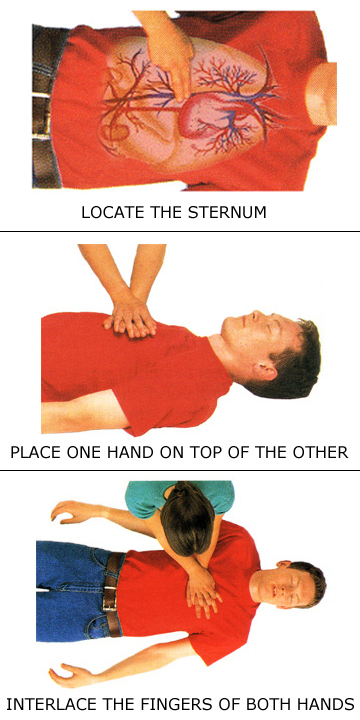Adult Compressions
PERFORMING CPR
 Studies of out-of-hospital adult cardiac arrest incidents have shown that survival rate was significantly higher whenever bystanders attempted to administer CPR with emphasis on blood flow and not solely on the precise sequence of compressions and rescue breaths. In other words, rather than not attempt CPR for fear of doing it incorrectly, it is more important to remember to push vigorously (i.e. hard and fast) than to remember exactly how many times to push.
Studies of out-of-hospital adult cardiac arrest incidents have shown that survival rate was significantly higher whenever bystanders attempted to administer CPR with emphasis on blood flow and not solely on the precise sequence of compressions and rescue breaths. In other words, rather than not attempt CPR for fear of doing it incorrectly, it is more important to remember to push vigorously (i.e. hard and fast) than to remember exactly how many times to push.
Before commencing CPR first determine if the victim has a pulse. To do this in an adult victim, place two fingertips on his carotid artery which is located in the depression between the windpipe and the neck muscles, and apply slight pressure for several, but no more than 10, seconds. At the same time observe the victim’s chest and face for signs of normal breathing. If no pulse is detected or you are not sure, it’s best not to waste precious moments, and to immediately begin chest compressions.
“C” is for COMPRESSIONS
Place the heel of your dominant hand on the victim’s sternum, the flat chest bone in the center of the nipple line. Then place your other hand on top and interlace the fingers.
Lock your elbows and using your body’s weight, compress the victim’s chest to the depth of at least 2 inches for an average adult, not exceeding 2.4 inches – a good way to remember is 2 hands, 2 inches [show me] – at a brisk rate of 100 to 120 compressions per minute (that’s nearly 2 compressions per second). It’s critical to remember to avoid leaning on the victim’s chest between compressions to allow full recoil of his thoracic cavity – you should be able to swipe a credit card between your hands and the victim chest after each compression.
If you feel or hear a slight cracking sound, do not become alarmed and do not stop your efforts! Many rescuers fail to compress sufficiently deeply for fear of further injuring the victim but damaged cartilage or cracked ribs are far less serious than a lost life.